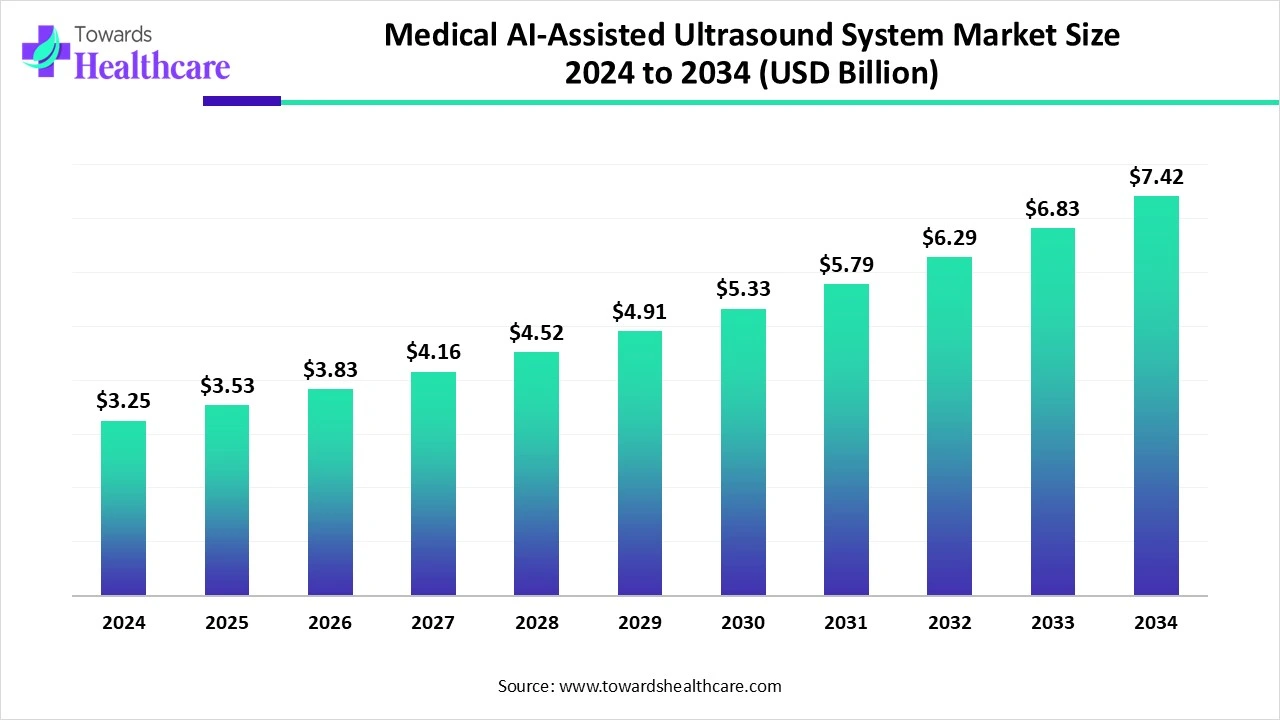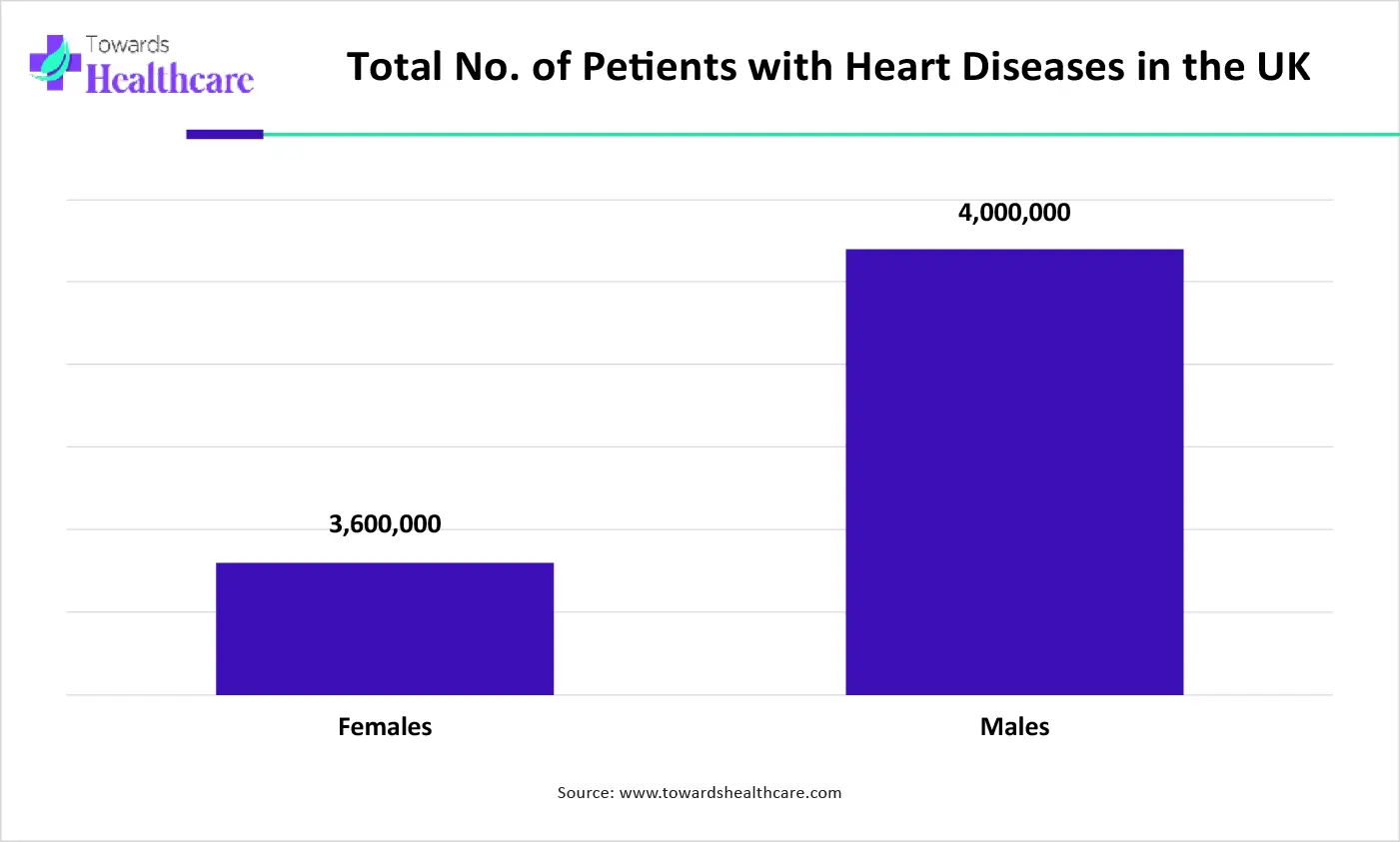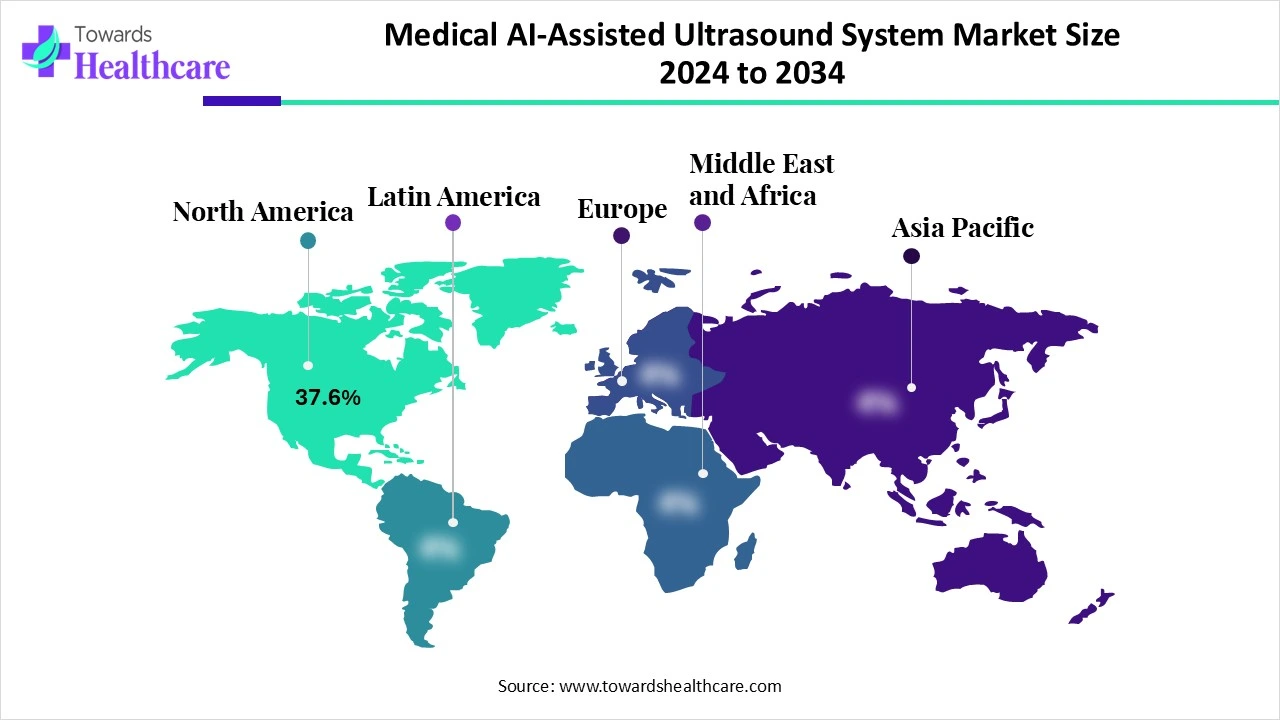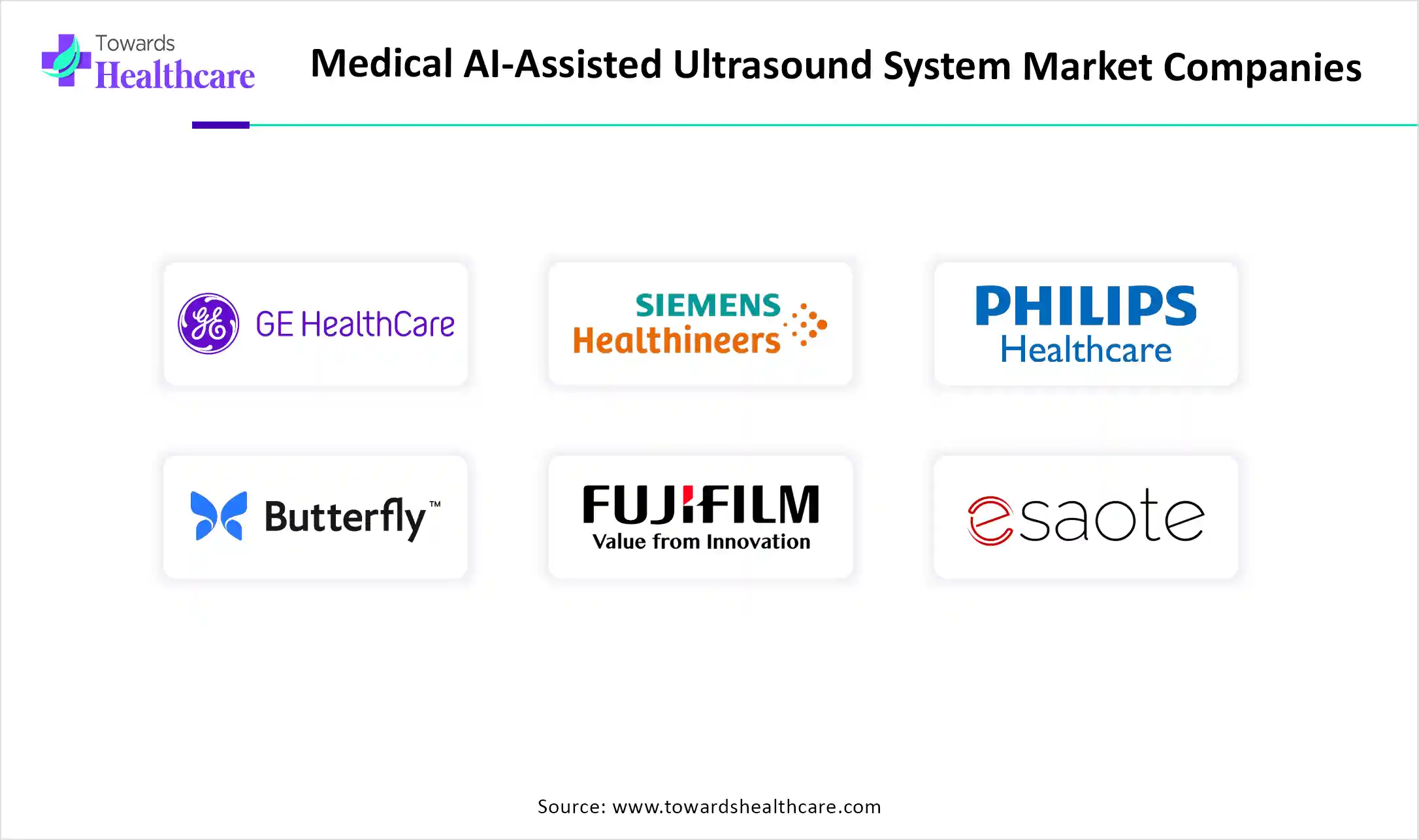December 2025

The global medical AI-assisted ultrasound system market size is calculated at US$ 3.25 billion in 2024, grew to US$ 3.53 billion in 2025, and is projected to reach around US$ 7.42 billion by 2034. The market is expanding at a CAGR of 8.64% between 2025 and 2034.

The demand for medical AI-assisted ultrasound systems is increasing as they provide fast and accurate results. This is increasing the interest of companies to develop such platforms, which is leading to new collaborations and the launching of funding rounds. They are also launching an upgraded version of the same to enhance the detection of diseases and increase its accessibility. Advanced R&D sectors, growing healthcare investments, and increasing utilization of AI technologies are increasing their development and adoption in different regions. Thus, this promotes the market growth.
| Metric | Details |
| Market Size in 2025 | USD 3.53 Billion |
| Projected Market Size in 2034 | USD 7.42 Billion |
| CAGR (2025 - 2034) | 8.64% |
| Leading Region | North America Share by 37.6% |
| Market Segmentation | By Product Type, By AI Functionality, By Application, By End User, By Mode of Deployment, By Region |
| Top Key Players | GE HealthCare, Siemens Healthineers, Philips Healthcare, Canon Medical Systems Corporation, Butterfly Network, Inc., Samsung Medison, FUJIFILM Healthcare, Mindray Medical International Limited, Esaote SpA, Clarius Mobile Health, EchoNous, Inc., Caption Health, Exo, Inc., Ultrasound AI, Inc., KOIOS Medical, Bay Labs, Inc., SoniVie Ltd., SonoScape Medical Corp., Remedi Technologies, Hitachi Healthcare |
The medical AI-assisted ultrasound system market refers to the segment of diagnostic imaging technology where artificial intelligence (AI) is integrated with ultrasound systems to automate, enhance, and accelerate image acquisition, interpretation, and decision-making. These systems use machine learning, deep learning, and computer vision algorithms to improve accuracy in detecting anatomical anomalies, reduce operator dependency, assist in real-time guidance, and support clinical workflows across multiple specialties such as cardiology, obstetrics, emergency medicine, and oncology. AI functionalities may include automated measurement, anomaly detection, image optimization, predictive diagnostics, and cloud-based analytics support.
Growing Demands for Accurate Diagnosis
The growing health concerns are increasing the demand for accurate and early diagnostic tools. This is increasing the development of medical AI-assisted ultrasound systems. These systems provide accurate diagnosis along with their precise interpretation with the use of AI. It also helps in reducing the chances of unnecessary treatments or improper diagnoses due to minimized errors. Using the data obtained from these systems, personalized treatment plans can be provided to the patient. Thus, this increases patient satisfaction and promotes the medical AI-assisted ultrasound system market growth.
Data privacy Concerns and Skepticism
The medical AI-assisted ultrasound system consists of a large volume of patient data. The chances of data breaches increase, which can leak the sensitive data of the patient. Moreover, the doctors or clinicians cannot fully trust them due to the fear of misdiagnosis and wrong results. Thus, this, in turn, limits their use and can lead to dissatisfaction and trust issues.
Why is the Increasing Adoption of Point-of-Care AI Ultrasound Systems an Opportunity in the Market?
To provide a faster and more accessible ultrasound platform, the development of point-of-care AI ultrasound systems is increasing. These systems provide fast interpretations and clinical decisions. Hence, their use in the detection of various diseases is increasing. Moreover, various innovations are being conducted to improve their accessibility by connecting them to mobile apps. Furthermore, to provide the most cost-effective solutions, they are also focusing on the development of cloud-based systems. Thus, this is promoting the medical AI-assisted ultrasound system market growth.
For instance,
By product type, the cart/trolley-based AI ultrasound systems segment held the largest share of 42.3% share in the medical AI-assisted ultrasound system market in 2024. It was mostly used in radiology departments and ICUs, due to their high imaging capacity. They provided accurate detection of anomalies. This increased their use and contributed to the market growth.
By product type, the handheld AI ultrasound systems segment is expected to show the highest growth at a notable CAGR during the upcoming years. Their use is increasing as they are affordable and portable. Thus, they are being used for at-home testing. This is enhancing the patient's convenience.
By AI functionality type, the image interpretation and diagnostics segment led the medical AI-assisted ultrasound system market with a 36.1% share in 2024. This helped in the detection of any lesions or anomalies due to diseases. It also reduced the chances of human errors, enhancing patient outcomes. Thus, it was used in various hospitals and specialty clinics.
By AI functionality type, the real-time guidance and navigation segment is expected to show the fastest growth rate during the forthcoming years. Real-time guidance and navigation are increasingly used in the ICU sector for faster and improved interpretations. Moreover, it does not require trained or expert personnel.
By application type, the cardiology segment held a dominating share of 24.7% in the medical AI-assisted ultrasound system market in 2024. The growing incidence of cardiovascular diseases is increasing the demand and use of these systems. AI can diagnose complex conditions easily, which minimizes the chances of further complications. This enhances the market growth.

The graph represents the total number of patients with heart disease in the UK. It indicates that there will be a rise in heart disease. Hence, it increases the demand for medical AI-assisted ultrasound systems for their accurate and early detection. Thus, this in turn will ultimately promote the market growth.
By application type, the emergency and critical care segment is expected to show the highest growth during the upcoming years. Due to their fast results and portability, they are being used in ambulances as well as during any critical conditions. Moreover, their clinical decisions help provide personalized treatment plans. This is increasing their use in various life-threatening conditions.
By end user, the hospitals segment led the global medical AI-assisted ultrasound system market with a 47.9% share in 2024. A large volume of patients were diagnosed with the use of these systems in hospitals. Additionally, different departments used these systems, which enhanced their acceptance rates. Moreover, their reduced number of errors helped in enhancing the patient outcomes.
By end user, the ambulatory surgical centers segment is expected to show the highest growth during the predicted time. These systems are being used before as well as after the operations in these centres to monitor the disease conditions. At the same time, their minimally invasive approach is increasing their utilization.
By mode of deployment type, the on-premise AI solutions segment held the largest share of 53.2% in the medical AI-assisted ultrasound system market in 2024. They helped in processing of vast amount of data quickly. Additionally, they were also used in rural hospitals, as they were not affected by low-connectivity settings. This promoted the market growth.
By mode of deployment type, the cloud-based AI ultrasound platforms segment is expected to show the fastest growth rate during the predicted time. This is enabling the flexibility and accessibility of the systems. Moreover, continuous updates are improving its performance. Furthermore, their use in telemedicine is also increasing.

North America dominated the medical AI-assisted ultrasound system market in 2024. North America consists of a well-developed research and development sector along with advanced technologies. This enhanced the development of these systems. Thus, this contributed to the market growth.
The U.S. consists of well-established research and development sectors. This, in turn, is enhancing the development and innovations of the ultrasound systems. Moreover, the growing investment from various industries is also contributing to the same. The regulatory guidelines are also provided, which are accelerating the development and approvals.
The growing cancer and cardiology burden is driving the demand for the use of medical AI-assisted ultrasound systems. At the same time, the hospitals are increasingly utilizing these systems, which are supported by the digital infrastructure. Moreover, the presence of reimbursement policies supports their development and adoption.
Asia Pacific is expected to host the fastest-growing medical AI-assisted ultrasound system market during the forecast period. Asia Pacific is experiencing a rise in healthcare investments. This is increasing the development and the adoption of medical AI-assisted ultrasound systems, along with other platforms and technologies. This is enhancing the market growth.
Due to the growing health concerns, the use of medical AI-assisted ultrasound systems in China is increasing. Thus, the startups, along with other major industries, are developing these systems at reasonable prices. Furthermore, regulatory support is also providing fast-track approvals.
The expanding healthcare in India is increasing the development of various such systems. Moreover, new point-of-care or portable AI-assisted ultrasound systems are also being developed. To make them affordable and to accelerate their development, investments as well as strategies are being provided by the government.
Europe is expected to grow significantly in the medical AI-assisted ultrasound system market during the forecast period. The increasing adoption of AI in the healthcare sector is driving various innovations in Europe. The growing collaboration is also leading to new developments of these systems. Thus, this is promoting the market growth.
Germany consists of a well-developed healthcare infrastructure, which is adopting these ultrasound systems. Moreover, the use of 3D/4D ultrasound systems is also increasing for the accurate diagnosis of various diseases. Fund from both the government and private sectors are supporting their development and clinical trials.
The UK industries are collaborating to accelerate the research and development of different AI-powered ultrasound systems. This, in turn, is improving the accuracy as well as the efficiency of the systems. Moreover, the reimbursement policies and well-developed hospitals with these technologies are attracting patients, enhancing the medical AI-assisted ultrasound system market growth.

In July 2025, for the development of quantitative ultrasound imaging and AI-driven clinical tools for the detection and monitoring of liver diseases, a collaboration between Siemens Healthineers and Apollo Hospitals, was announced, where the Managing Director of Siemens Healthcare, Hariharan Subramanian, stated that it is necessary to use advanced diagnostic tools, increase awareness, and change lifestyles for the prevention and early diagnosis of liver diseases, which are a growing health concern in India. They believe the disease management and quality of life for patients will be enhanced with the use of advanced technologies, as they can serve as precise and timely diagnosis tools. Thus, the liver disease diagnosis and treatment unmet needs will be addressed by this collaboration.
By Product Type
By AI Functionality
By Application
By End User
By Mode of Deployment
By Region
December 2025
December 2025
December 2025
December 2025